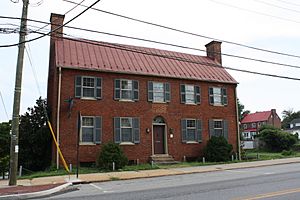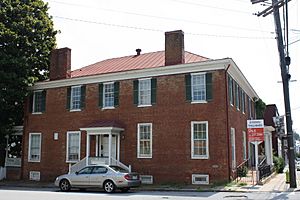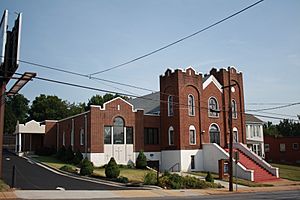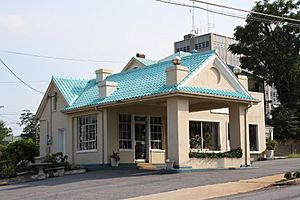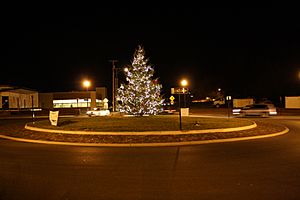Fifth Street Historic District facts for kids
|
Fifth Street Historic District
|
|
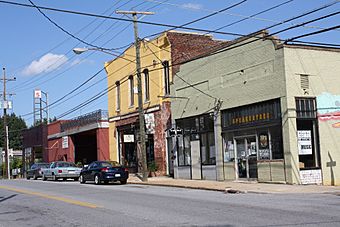
600 Block Fifth Street, August 2011
|
|
| Location | 5th, 6th, Court, Clay, Madison, Harrison, Federal, Jackson, Polk, & Monroe Sts., Lynchburg, Virginia |
|---|---|
| Area | 23 acres (9.3 ha) |
| Built | 1806 |
| Architect | Johnson, Stanhope S. |
| NRHP reference No. | 12000019 |
Quick facts for kids Significant dates |
|
| Added to NRHP | February 8, 2012 |
The Fifth Street Historic District is a special area in Lynchburg, Virginia, known for its important history. It's like a time capsule with 57 old buildings and one object that tell stories about the past. This district was once a busy center for the African-American community in Lynchburg. It has all kinds of buildings, like homes, shops, and community centers. About half of these buildings were built between 1875 and 1940.
Some famous buildings in the district include the Kentucky Hotel, the Western Hotel, the William Phaup House, and the Pyramid Motors building. Other cool places are the Augustine Leftwich House (built around 1817), old tobacco factories (from 1877-1885), the Humbles Building (1915), and the Fifth Street Baptist Church (1929).
This historic district was added to the National Register of Historic Places in 2012, meaning it's officially recognized as a place worth protecting for its history.
Contents
Exploring Fifth Street's History
Where is Fifth Street Located?
The Fifth Street Historic District is right in the middle of Lynchburg, Virginia. It's next to the city's main downtown shopping area. The district stretches for about 2,500 feet, covering eight blocks along Fifth Street. Fifth Street itself is about a mile long and runs from the John Lynch Bridge in the northeast to the Dr. Martin Luther King, Jr. Bridge in the southwest.
Fifth Street is currently known as State Route 163. It used to be part of a much bigger road, U.S. Route 29, which connected Maryland all the way to Florida! This shows how important Fifth Street was for travel. The street is also honorably called Martin Luther King, Jr. Boulevard.
A main cross street in the district is Federal Street. It meets Fifth Street at a cool, single-lane roundabout that was finished in 2010. Other streets that cross Fifth Street in the district include Court, Clay, Madison, Harrison, Jackson, and Polk Streets.
How Fifth Street Began
Lynch's Ferry and the Old Road
The story of Fifth Street starts way back in the 1700s. In 1757, Edward Lynch got permission to start a ferry across the James River. His younger brother, John Lynch, who was only 17, is said to have run the ferry. John also built a "Ferry House" (like a hotel) for travelers waiting to cross the river.
Before the ferry, people crossed the river at a shallow spot called the "Horse Ford." A road led to this ford, and as it got closer to Lynch's Ferry, it became the path that we now know as Fifth Street. This old road was called the "Ferry Road."
Lynchburg Town is Born
In 1786, a town called "Lynchburg" was officially created on John Lynch's land. It started small, with 45 acres, divided into blocks and lots. The roads that ran parallel to the James River were wide, and the roads that ran perpendicular (like alleys) were narrower. At first, there were only four alleys, and the one farthest west was called "Third Alley" (now Seventh Street).
By 1796, Lynchburg had about 100 houses and was growing fast because it was a good place for trade. In 1805, Lynchburg became an official town. It expanded, and "Seventh Alley" (which became Fifth Street) and "Sixth Alley" (which became Twelfth Street) became the main ways to get into town.
Growing in the Early 1800s
In 1806, John and Mary Lynch gave the town a piece of land on a hill to use as a public cemetery. This cemetery, now called the Old City Cemetery, was placed on the edge of town but still easy to reach. With the main business area to the north and the cemetery to the south, the path of Fifth Street was set by 1806. Around this time, Fifth Street was also sometimes called Cocke Street or West Street.
Over the next 20 years, Lynchburg grew bigger, and more of the Fifth Street area became part of the town. By 1826, most of Fifth Street was inside the town limits.
Early homes in Lynchburg were often made of wood because it was cheap and easy to find. However, many of these wooden buildings are gone now. By the 1810s, Lynchburg started to build more homes and businesses out of brick, which lasted much longer.
Old Hotels, Shops, and Homes
The Kentucky Hotel
Two of Lynchburg's oldest surviving hotels from the early 1800s are in the Fifth Street Historic District. The Kentucky Hotel at 900 Fifth Street might have been built as early as 1800. It's a brick building with a classic look, featuring a central front door with a fanlight (a window shaped like a fan). The hotel has a unique brick cornice (a decorative molding at the top of the wall), which is rare for buildings of that time in Lynchburg.
Western Hotel/Nichols' Tavern
Another old hotel, known as Nichols' Tavern or the Western Hotel, is at 600 Fifth Street. It was built in 1815 after the previous building burned down. This hotel was designed to welcome travelers, likely having entrances on both Fifth Street and Madison Street. It was expanded in the 1830s or 1840s, adding more space and a columned porch.
Other Early Shops
Two smaller, very old buildings from the early 1800s are found on the 600 and 700 blocks of Fifth Street. The wooden building at 708 Fifth Street, built around 1820, is a rare example of an early wooden shop in Lynchburg. It once had a balcony that hung over Fifth Street, a common feature back then that has now disappeared from the area.
The brick building at 612 Fifth Street, likely built in 1827, is another rare survivor from the early 19th century. It shows how buildings were designed for both homes and businesses back then.
Homes from the Federal Period
You can also find a group of old homes from the Federal period (early 1800s) near Fifth Street, on Federal, Jackson, and Polk Streets. The Augustine Leftwich House, built around 1817, is one of the largest wooden houses from that time in Lynchburg. It has a unique L-shape and a porch with a balcony.
The house at 523 Jackson Street, built in 1814, is another rare example of a three-bay wooden house from the early 1800s. It sits on a high stone basement and has an original back porch.
Across the street, 522 Jackson is an interesting brick house built in 1817. The William Phaup House at 911 Sixth Street, also built in 1817, looks like a mirror image of the house at 522 Jackson. These homes show the different styles of building from that time.
Another old brick house, at 514 Polk Street, was probably built around 1817 as an investment. It started as a two-bay building, and a third bay was added later.
Tobacco Factories in the Mid-1800s
A group of important buildings in the district are old tobacco factories, found on the 400 block of Court Street. These factories were very common in Lynchburg during the 1800s. The tobacco factories at 409 Court Street and 410 Court Street, built between 1877 and 1885, are the largest historic buildings in the district. They are made of brick and show how important the tobacco industry was to Lynchburg.
Early 1900s Shops
Around 1900, many older wooden buildings on Fifth Street were replaced with bigger, stronger brick commercial buildings. For example, the building at 500 Fifth Street, built in 1906, had two storefronts. The Humbles Building at 901 Fifth Street, built in 1915, is an impressive three-story building with yellow brick.
The M.R. Scott Meat Market at 700 Fifth Street, designed in 1919, is one of the most beautiful buildings on the street. It features marble details and decorative brickwork. These buildings show the growth and changing styles of businesses on Fifth Street in the early 20th century.
Buildings for Cars
As cars became popular, Fifth Street changed to serve them. One of the first car-related buildings was for the Miller Tire and Battery Company at 400 Fifth Street, built in 1927. It had a special covered driveway where drivers could stop to check their tires without getting wet.
The Adams Motor Company building at 811 Fifth Street, also built in 1927, was huge and could hold showrooms for three different car dealers. It has large arched windows. Another big car showroom, Pyramid Motors, was built in 1937 at 407 Federal Street. This building has a cool Art Deco style with yellow and red brick.
Other car-related buildings include Hoskins Pontiac (1951) and Burnett Tire Company (1956), which has a striking modern glass storefront. Several old gas stations are also along Fifth Street, like the Spanish Revival-style station at 1100 Fifth Street, built in 1927.
Other Important Buildings
Moser Furniture Company
The Moser Furniture Company building at 409 Fifth Street, built in 1936, looks more like a house than a store. It's in the Colonial Revival style, with a steep roof, dormer windows, and brick laid in a special pattern. It also has a large warehouse in the back.
Fifth Street Baptist Church
The Fifth Street Baptist Church at 1007-1013 Fifth Street is the only church in the district. Built in 1929, it has a Gothic Revival style, with tall towers and beautiful arched stained glass windows.
Community Funeral Home
The Community Funeral Home at 909 Fifth Street looks very modern, but it's actually an old building from 1922 that was given a new look in 1976. The new design covered the old brick facade to create a fresh, unified look with a new addition.
Apartment Buildings
Two apartment buildings from the mid-1900s are also worth mentioning. The duplex at 411-413 Polk Street, built in 1940, is a simple brick building with two front doors. The Tal-Fred Apartments at 600 Monroe Street, built around 1940, is a large brick building that once had six big apartment units. It later became home to the Y.W.C.A.
Why Fifth Street is Important
The Fifth Street Historic District covers about 23 acres and includes commercial areas and homes southwest of downtown Lynchburg. It has over 55 historic buildings.
Fifth Street started as a main entrance to Lynchburg in the early 1800s, connecting the growing town to areas further west. This is why you see old businesses like the Kentucky Hotel and Western Hotel, which served travelers.
Even though it was also a residential area for white residents, Fifth Street became the main business hub for Lynchburg's African-American community, especially from the late 1800s through the mid-1900s. A report from 1940 described Fifth Street as a place where African Americans could find "their street," with shops, cafes, barbershops, and theaters run by and for black people. It was a place where they felt proud and didn't have to deal with the same discrimination they faced elsewhere.
Fifth Street also became a major center for car sales and services, with gas stations, tire shops, and car showrooms.
The history of Fifth Street spans from 1800 to 1964. It's important for its role in Lynchburg's business and transportation growth. It's also very important as a center of African-American business and culture. Plus, it has many great examples of different building styles, like Federal, Art Deco, and Colonial Revival.
Architecture Styles
The Fifth Street Historic District shows off many different architectural styles, proving its importance as a business center for over a century. It has some of the oldest homes and businesses in Lynchburg, second only to the Federal Hill Historic District. Two of the city's three remaining taverns from the early 1800s, the Kentucky Hotel and Nichols Tavern, are here.
You can also see rare examples of early 19th-century townhouses and stores, like those at 612 and 708 Fifth Street. The district also features cool car-oriented buildings, such as the Adams Motor Company building, the Art Deco-style Pyramid Motors, and modern showrooms.
A Busy Road for Business and Travel
In 1805, Lynchburg officially became a town, and new roads, including Seventh Alley (Fifth Street), were made official. The old Ferry Road, which had been used since 1757, merged with Seventh Alley. This meant travelers heading west would cross the James River, go up Water Street, turn onto Second Street, and then onto Seventh Alley (Fifth Street). This made Fifth Street a perfect spot for businesses to grow.
Before 1805, most businesses in Lynchburg were on Main Street. But because of the heavy traffic going west, Fifth Street quickly became popular. It was even called "Cocke Street" after a merchant who owned land there, or "West Street" because it led west.
The popularity of Fifth Street as a travel route led to many taverns being built there in the early 1800s. The Kentucky Hotel, for example, became a major landmark, often mentioned in old road descriptions. Joseph Nichols' Tavern, built in 1815, was so important that the community helped rebuild it quickly after it burned down. These two taverns are significant because only three from that period are believed to remain in Lynchburg today.
Shops also started to open along Fifth Street. Merchants like Archibald Robertson and Lindsay B. Padgett had stores there. The buildings at 612 and 708 Fifth Street are rare examples of commercial buildings from before 1830.
Improvements to the roads, like connecting Fifth Street to the Lynchburg & Salem Turnpike, helped keep Fifth Street a busy commercial center throughout the 1800s.
During the Civil War, Fifth Street played a role in the city's defense. Many large buildings, including tobacco warehouses on Fifth Street, were used as hospitals for wounded soldiers. Cadets from the Virginia Military Institute even slept among the gravestones at the Old City Cemetery while digging defense lines on College Hill.
After the war, tobacco factories continued to thrive on Fifth Street. Two examples, the R.E. Gist's Plug and Twist Tobacco Factory and A.M. Bruce's Plug and Smoking Tobacco Factory, built between 1877 and 1885, are still in the district.
In 1883, a new fire station was built at 514 Fifth Street. Biggers School, a public school for 305 students, opened in 1881 at Clay and Fifth Streets (it was torn down in 1967). By the late 1800s, Fifth Street was home to bakeries, grocery stores, ice cream parlors, drug stores, and more.
By the early 1900s, cars changed everything. New businesses like gas stations and tire stores popped up. The Miller Tire & Battery Company and the Adams Motor Company building were among the first car-related businesses on Fifth Street. The Pyramid Motor Corporation, which sold Ford cars, also built a dealership here.
Fifth Street was also a major route for buses. In 1930, a Greyhound bus terminal was built, and in 1953, a Trailways bus station opened, later becoming a shared "Union Bus Station" for both companies.
In 1931, Fifth Street became part of U.S. Highway 29, a major north-south road. Even after a new bypass was built, Fifth Street remained important for local traffic. However, like many downtown areas in the 1970s, Fifth Street saw a decline as large shopping malls opened.
African American Business and Culture
After the Civil War, African Americans faced new challenges and opportunities. Despite racial discrimination, black communities created their own businesses and services.
In the late 1800s, Fifth Street began to see more African-American residents and business owners. By 1910, a thriving black business district had formed between Federal and Monroe Streets. Successful black business leaders and community groups invested in the area, building large commercial buildings. Early black business owners included shoemakers, grocers, and barbers.
Many black fraternal organizations were formed, offering social support and promoting "self-help" within the community. In 1893, the Order of True Reformers, a black fraternal group, built the True Reformers Hall on Fifth Street. This large building had an auditorium, offices, and shops, serving as a cultural, social, and business hub for the African-American community (it was torn down in 1985).
Even as the tobacco industry changed, some factories, like Stalling & Company, continued to employ African Americans. As opportunities grew, black entrepreneurship increased. By 1904, Lynchburg's black population ran billiard saloons, theaters, and livery stables. There were black doctors, undertakers, lawyers, and many barbers and merchants.
Around 1900, the Kentucky Hotel became home to Smith's Business College, which offered education to African Americans. Its director, T. Parker Smith, was a pioneer in training black individuals in business.
In 1915, Adolphus Humbles, a successful African-American businessman, built the Humbles Building at 901 Fifth Street. This three-story building had shops and an auditorium. Humbles was also active in politics and community leadership.
In 1919, the Gist Tobacco Factory at 410 Court Street was turned into Mill No. 2 of the Lynchburg Hosiery Mills Company. This mill specifically hired African-American women, who previously had limited job options outside of domestic work. The mill employed 150-200 black women until 1971.
Fifth Street was also home to many African-American funeral homes, like the Community Funeral Home, which was started by M.W. "Teedy" Thornhill, Jr., who later became Lynchburg's first African-American mayor.
In 1918, a group of African-American women started Y.W.C.A. programs for women of color at 613 Monroe Street. This became the official Phyllis Wheatley Branch in Lynchburg. In 1950, the branch moved to a larger, more modern building at 600 Monroe Street, which is still owned by the Y.W.C.A. today.
Fifth Street also became the center for health and medicine in the African-American community. By 1940, almost all of Lynchburg's black doctors and dentists had offices on Fifth Street. Dr. R. Walter Johnson, a famous African-American physician, had his office at 1001 Fifth Street. He was the first African American allowed to practice at Lynchburg General Hospital and was a well-known tennis coach for young black players like Arthur Ashe.
Other notable black medical professionals included Dr. Fred L. Lander, Jr., Dr. Leon Braswell, and Dr. Clarissa Wimbush, the first black female dentist in Virginia. Dr. Augustus Nathaniel Lushington, believed to be one of the first African Americans in the country to get a veterinary medicine degree, also had his practice on Fifth Street.
Pharmacist Harry W. Reid opened the only black-owned and operated drugstore in Lynchburg on Fifth Street, which was a great credit to the city.
Whit N. Brown, known as the "King of Fifth Street," was a successful real estate owner. When he died in 1946, he donated his entire estate, including a brick duplex on Polk Street, to Lynchburg General Hospital.
Today, the Legacy Museum of African American History at 403 Monroe Street continues to celebrate black culture and history in the region.
Fifth Street Today
For over 200 years, Fifth Street has been a vital part of Lynchburg's business and transportation. It was also the heart of the region's African-American community for more than a century. While some buildings have been lost over time, the district still feels like a historic urban business area.
In recent years, there's been new interest in improving Fifth Street. Organizations like the Fifth Street Community Development Corporation and the Lynchburg Neighborhood Development Foundation are working to restore buildings and improve the area. They've helped expand other historic districts and are working on new projects to bring life back to Fifth Street. Major improvements to the streets and utilities were completed in 2013, showing a renewed commitment to this important historic area.
Images for kids




